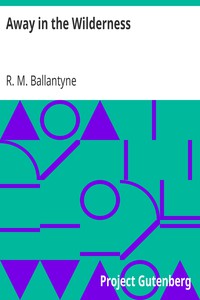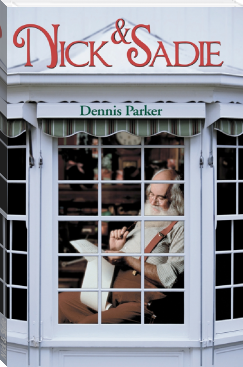Away in the Wilderness, R. M. Ballantyne [best inspirational books .TXT] 📗

- Author: R. M. Ballantyne
Book online «Away in the Wilderness, R. M. Ballantyne [best inspirational books .TXT] 📗». Author R. M. Ballantyne
It is very different with the plain Indians. These savages have numbers of fine horses, and live in a splendid open country, which is well-stocked with deer and buffaloes, besides other game. They are bold riders, and scour over the country in all directions, consequently the different tribes often come across each other when out hunting. Quarrels and fights are the results, so that these savages are naturally a fierce and warlike race. They are independent too; for although they get their guns and ammunition and other necessaries from the traders, they can manage to live without these things if need be. They can clothe themselves in the skins of wild animals, and when they lose their guns, or wet their powder, they can kill game easily with their own bows and arrows.
It was a band of these fellows that now went galloping towards Fort Erie, with the long manes and tails of the half-wild horses and the scalp-locks on their dresses and their own long black hair streaming in the wind.
Pemberton and his party soon came up with the young Indians who had remained to chase the buffaloes. He found them sheltered behind a little mound, making preparations for an immediate attack on the animals, which, however, were not yet visible to the men from the fort.
“I do believe they’ve seen buffaloes on the other side of that mound,” said Pemberton, as he rode forward.
He was right. The Indians, of whom there were six, well mounted and armed with strong short bows, pointed to the mound, and said that on the other side of it there were hundreds of buffaloes.
As the animals were so numerous, no objection was made to the fur-traders joining in the hunt, so in another moment the united party leaped from their horses and prepared for action. Some wiped out and carefully loaded their guns, others examined the priming of their pieces, and chipped the edges off the flints to make sure of their not missing fire. All looked to the girths of their saddles, and a few threw off their coats and rolled their shirt-sleeves up to their shoulders, as if they were going to undertake hard and bloody work.
Mr Pemberton took in hand to look after our friend Heywood; the rest were well qualified to look after themselves. In five minutes they were all remounted and rode quietly to the brow of the mound.
Here an interesting sight presented itself. The whole plain was covered with the huge unwieldy forms of the buffaloes. They were scattered about, singly and in groups, grazing or playing or lying down, and in one or two places some of the bulls were engaged in single combat, pawing the earth, goring each other, and bellowing furiously.
After one look, the hunters dashed down the hill and were in the midst of the astonished animals almost before they could raise their heads to look at them. Now commenced a scene which it is not easy to describe correctly. Each man had selected his own group of animals, so that the whole party was scattered in a moment.
“Follow me,” cried Pemberton to Heywood, “observe what I do, and then go try it yourself.”
The fur-trader galloped at full speed towards a group of buffaloes which stood right before him, about two hundred yards off. He carried a single-barrelled gun with a flint lock in his right hand and a bullet in his mouth, ready to re-load. The buffaloes gazed at him for one moment in stupid surprise, and then, with a toss of their heads and a whisk of their tails, they turned and fled. At first they ran with a slow awkward gait, like pigs; and to one who did not know their powers, it would seem that the fast-running horses of the two men would quickly overtake them. But as they warmed to the work their speed increased, and it required the horses to get up their best paces to overtake them.
After a furious gallop, Pemberton’s horse ran close up alongside of a fine-looking buffalo cow—so close that he could almost touch the side of the animal with the point of his gun. Dropping the rein, he pointed the gun without putting it to his shoulder and fired. The ball passed through the animal’s heart, and it dropt like a stone. At the same moment Pemberton flung his cap on the ground beside it, so that he might afterwards claim it as his own.
The well-trained horse did not shy at the shot, neither did it check its pace for a moment, but ran straight on and soon placed its master alongside of another buffalo cow. In the meantime, Pemberton loaded like lightning. He let the reins hang loose, knowing that the horse understood his work, and, seizing the powder-horn at his side with his right hand, drew the wooden stopper with his teeth, and poured a charge of powder into his left—guessing the quantity, of course. Pouring this into the gun he put the muzzle to his mouth, and spat the ball into it, struck the butt on the pommel of the saddle to send it down, as well as to drive the powder into the pan, and taking his chance of the gun priming itself, he aimed as before, and pulled the trigger. The explosion followed, and a second buffalo lay dead upon the plain, with a glove beside it to show to whom it belonged.
Scenes similar to this were being enacted all over the plain, with this difference, that the bad or impatient men sometimes fired too soon and missed their mark, or by only wounding the animals, infuriated them and caused them to run faster. One or two ill-trained horses shied when the guns were fired, and left their riders sprawling on the ground. Others stumbled into badger-holes and rolled over. The Indians did their work well. They were used to it, and did not bend their bows until their horses almost brushed the reeking sides of the huge brutes. Then they drew to the arrow heads, and, leaning forward, buried the shafts up to the feathers. The arrow is said to be even more deadly than the bullet.
Already the plain was strewn with dead or dying buffaloes, and the ground seemed to tremble with the thunder of the tread of the affrighted animals. Jasper had ‘dropt’ three, and Arrowhead had slain two, yet the pace did not slacken—still the work of death went on.
Having seen Pemberton shoot another animal, Heywood became fired with a desire to try his own hand, so he edged away from his companion. Seeing a very large monstrous-looking buffalo flying away by itself at no great distance, he turned his horse towards it, grasped his gun, shook the reins, and gave chase.
Now poor Heywood did not know that the animal he had made up his mind to kill was a tough old bull; neither did he know that a bull is bad to eat, and dangerous to follow; and, worse than all, he did not know that when a bull holds his tail stiff and straight up in the air, it is a sign that he is in a tremendous rage, and that the wisest thing a man can do is to let him alone. Heywood, in fact, knew nothing, so he rushed blindly on his fate. At first the bull did not raise his tail, but, as the rider drew near, he turned his enormous shaggy head a little to one side, and looked at him out of the corner of his wicked little eye. When Heywood came within a few yards and, in attempting to take aim, fired off his gun by accident straight into the face of the sun, the tail went up and the bull began to growl. The ferocious aspect of the creature alarmed the artist, but he had made up his mind to kill it, so he attempted to re-load, as Pemberton had done. He succeeded, and, as he was about to turn his attention again to the bull, he observed one of the men belonging to the fort making towards him. This man saw and knew the artist’s danger, and meant to warn him, but his horse unfortunately put one of its feet into a hole, and sent him flying head over heels through the air. Heywood was now so close to the bull that he had to prepare for another shot.
The horse he rode was a thoroughly good buffalo-runner. It knew the dangerous character of the bull, if its rider did not, and kept its eye watchfully upon it. At last the bull lost patience, and, suddenly wheeling round, dashed at the horse, but the trained animal sprang nimbly to one side, and got out of the way. Heywood was all but thrown. He clutched the mane, however, and held on. The bull then continued its flight.
Determined not to be caught in this way again, the artist seized the reins, and ran the horse close alongside of the buffalo, whose tail was now as stiff as a poker. Once more the bull turned suddenly round. Heywood pulled the reins violently, thus confusing his steed which ran straight against the buffalo’s big hairy forehead. It was stopped as violently as if it had run against the side of a house. But poor Heywood was not stopped. He left the saddle like a rocket, flew right over the bull’s back, came down on his face, ploughed up the land with his nose—and learned a lesson from experience!
Fortunately the spot on which he fell happened to be one of those soft muddy places in which the buffaloes are fond of rolling their huge bodies in the heat of summer, so that, with the exception of a bruised and dirty face, and badly soiled clothes, the bold artist was none the worse for his adventure.
Summer passed away, autumn passed away, and winter came. So did Christmas, and so did Jasper’s marriage-day.
Now the reader must understand that there is a wonderful difference between the winter in that part of the North American wilderness called Rupert’s land, and winter in our own happy island.
Winter out there is from six to eight months long. The snow varies from three to four feet deep, and in many places it drifts to fifteen or twenty feet deep. The ice on the lakes and rivers is sometimes above six feet thick; and the salt sea itself, in Hudson’s Bay, is frozen over to a great extent. Nothing like a thaw takes place for many months at a time, and the frost is so intense that it is a matter of difficulty to prevent one’s-self from being frost-bitten. The whole country, during these long winter months, appears white, desolate, and silent.
Yet a good many of the birds and animals keep moving about, though most of them do so at night, and do not often meet the eye of man. The bear goes to sleep all winter in a hole, but the wolf and the fox prowl about the woods at night. Ducks, geese, and plover no longer enliven the marshes with their wild cries; but white grouse, or ptarmigan, fly about in immense flocks, and arctic hares make many tracks in the deep snow. Still, these are quiet creatures, and they scarcely break the deep dead silence of the forests in winter.
At this period the Indian and the fur-trader wrap themselves in warm dresses of deer-skin, lined with the thickest flannel,





Comments (0)